Should TN Farmers Request Early Water Release as Periyar and Vaigai Dams Approach Full Capacity?

Synopsis
Key Takeaways
- Farmers in Madurai are advocating for early water release from the dams.
- This measure aims to support irrigation and groundwater recharge.
- The Periyar dam is currently at 135 feet, while the Vaigai dam is at 66.6 feet.
- Failure to act timely could lead to unnecessary flood releases.
- Formal requests have been submitted to the Water Resources Department.
Chennai, July 29 (NationPress) As the Periyar and Vaigai dams close in on their maximum storage levels due to significant inflow from surrounding catchment areas, farmers from the Madurai region have urged the Water Resources Department (WRD) to initiate an early release of water for irrigation purposes.
This action is vital for replenishing irrigation tanks and recharging groundwater supplies in rural sectors.
WRD officials report that the water level at the Periyar dam exceeded 135 feet as of Monday, just shy of the maximum allowable limit of 137.5 feet until August 10 according to the established regulation curve.
The inflow recorded at the dam is currently at 3,639 cusecs, with an outflow of 1,867 cusecs.
In contrast, the Vaigai dam's water level stands at 66.6 feet, nearing its full capacity of 71 feet, with an inflow of 1,989 cusecs and an outflow of 869 cusecs.
A preliminary flood alert was issued last week for both dams due to the ongoing increase in inflow from persistent rainfall in the upper catchment areas.
Officials predict that both reservoirs will reach full capacity shortly. Farmer leader Ganesh Senthil Raj from Melur noted that it is a rare occurrence for both dams to be close to full capacity by mid-year.
“Since the Periyar dam has already surpassed 135 feet, we must capitalize on the inflow. Tamil Nadu's quota from Periyar can be increased from 1,867 to 2,100 cusecs,” he proposed.
He also urged for the immediate release of water from the Vaigai dam into major canals including the Thirumangalam canal, Periyar main canal (which benefits Melur), the 58th canal, and the 18th canal.
“Even a brief release of water for just 10 days would only consume around 1.25 TMC, which can be stored in local tanks for future agricultural endeavors,” he stated, adding that formal requests have been submitted to the WRD.
Krishan Viswanathan, another farmer leader, emphasized that directing water through the 58th canal would assist in recharging groundwater and filling irrigation tanks in outer Madurai.
“If prompt measures are not taken, any surplus water will be forced to discharge as flood release, ultimately flowing into the sea without benefiting the farmers,” he cautioned.










